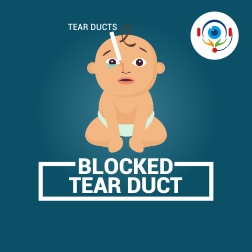Blocked Tear Duct
Disease
When the openings that allow our tears to go into the tear duct haven't been formed properly, it creates a blockage and prevents our tears from draining out. This condition is known as Congenital Lacrimal Duct Obstruction.
This is a very common condition among newborns, as it mostly presents itself at birth.
Blocked tear ducts exist in either one or both the eyes.
Not all blocked tear ducts resolve on their own. There is a close to 95% chance that blocked tear ducts will get resolved in children below the age of 1.
Causes
Tears are formed in the gland placed below the bone of the eyebrow or the lacrimal gland. Once produced, through two small openings located in the corner of the eyelids they drain into a larger passage that takes them from the eye to the inside of the nose.
This larger passage is known as the nasolacrimal duct or tear duct. Now, if the openings that allow the tears to enter the nose are deformed, it leads to a blocked tear duct.
As infants produce tears only several weeks after they're born, a blocked tear duct may not be noticeable when your child is born. Blocked tear ducts are noticeable if the baby cries or if in a place where it is cold or has windy weather as this type of climate stimulates tears.
The kind of symptoms a child experiences in this eye condition differs. Following are some of the most common symptoms children experience -
1. Tears draining down the eyelids and cheeks
2. Tears gathering together in the corner of the eyes
3. Constant rubbing resulting in redness of the skin
4. Mucus or a yellowish discharge in the eye
Diagnosis
While diagnosing a blocked tear duct, the doctor will take an account of your child's medical history along with a physical examination.
Treatment
All blocked tear ducts tend to open on their own by the time the child turns 1. However, if the tear duct continues to remain blocked there are various treatment options that your child's doctor will prescribe -
1. Milking/Massaging the Tear Duct: This is a very common method used to treat a blocked tear duct. Your child's physician will demonstrate to you how this needs to be done. You will be required to do this two to three times a day.
2. Antibiotics: If there are symptoms of infection, your child's doctor will prescribe antibiotics used particularly in the eye for your child.
Surgery
Another treatment option to unblock a blocked tear duct is to use a small probe to enlarge the duct opening. In most cases this procedure is effective, but sometimes may have to be repeated.
Takeaway
Tears are produced in the lacrimal gland, and help clean and lubricate our eyes. Therefore, if you notice symptoms of blocked tear ducts or suspect that your child could possibly have this eye condition, get your child diagnosed immediately. A diagnosis will eliminate the possibility of a bigger eye problem from occurring.



